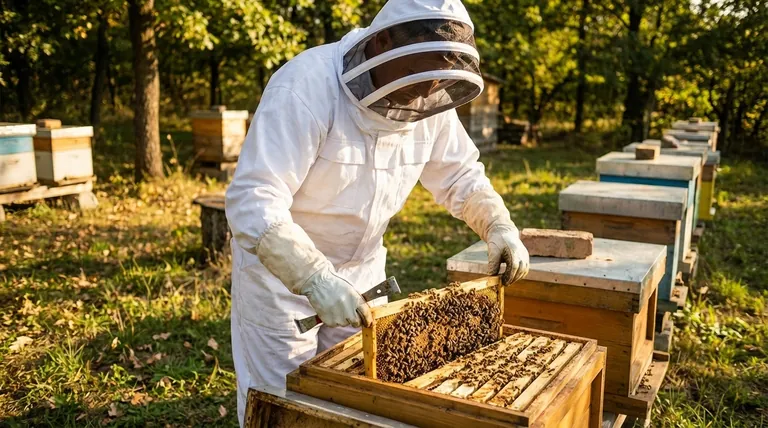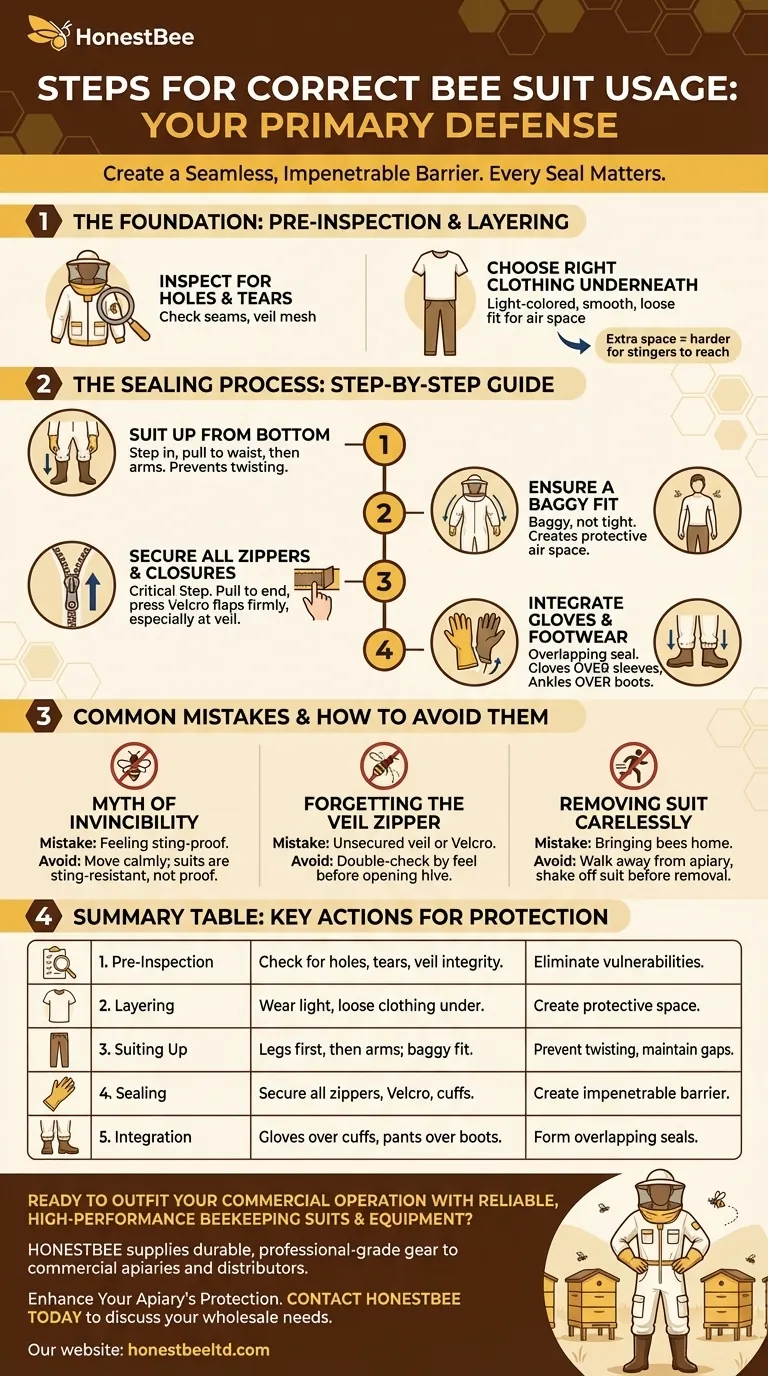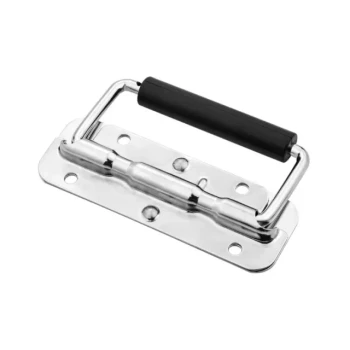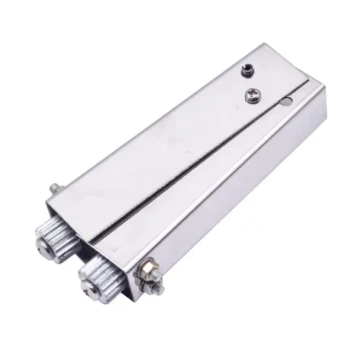Using a bee suit correctly is your primary defense when working with honey bees. The process involves more than just zipping up; it requires ensuring a snug but not tight fit, methodically securing every zipper, elastic band, and Velcro closure, and integrating proper gloves and boots to create a completely sealed barrier against stings.
Your goal is not just to wear a suit, but to create a seamless, impenetrable barrier. A bee suit's effectiveness is determined by its weakest point—a forgotten zipper or a small gap at the ankle is the only invitation a defensive bee needs.

The Foundation: Pre-Inspection and Proper Layering
Before you even approach a hive, proper preparation is essential. A few minutes of prep can prevent a difficult experience later.
Inspect for Holes and Tears
Always perform a quick visual inspection of your suit before putting it on. Pay close attention to the seams and the mesh of the veil, as these are common points of failure. A small hole is a significant vulnerability.
Choose the Right Clothing Underneath
Wear light-colored, smooth-fabric clothing under your bee suit. A loose fit is key. This extra layer provides additional space between the suit and your skin, making it much harder for a bee's stinger to reach you if it manages to penetrate the outer material.
The Sealing Process: A Step-by-Step Guide
Putting on your suit should be a deliberate, methodical process. Rushing this stage is where mistakes are made.
Step 1: Suit Up from the Bottom
Begin by stepping into the suit's legs. Pull the suit up to your waist before putting your arms through the sleeves. This ensures the garment doesn't get twisted.
Step 2: Ensure a Baggy Fit
The suit should be baggy, not tight. A snug fit pulls the fabric against your skin, reducing the distance a stinger has to travel. A loose, baggy fit creates protective air space around your body.
Step 3: Secure All Zippers and Closures
This is the most critical step. Secure all zippers completely, ensuring they are pulled all the way to the end of their tracks. Most suits have a Velcro flap that covers the termination point of the veil zippers—make sure this is pressed down firmly.
Step 4: Integrate Gloves and Footwear
Your defenses are only as strong as your connections. Pull your gloves over the elastic cuffs of the suit's sleeves. Likewise, ensure the elastic bands at the ankles are secure over your boots. This creates an overlapping seal that bees cannot crawl through.
Common Mistakes and How to Avoid Them
Even experienced beekeepers can make mistakes. Understanding common failure points is key to maintaining your safety and confidence.
The Myth of Invincibility
No bee suit makes you completely sting-proof; it makes you sting-resistant. Calm, deliberate movements are just as important as the suit itself. Aggressive or clumsy handling of the hive can provoke a response that even the best suit may not fully prevent.
Forgetting the Veil Zipper
The most common error is failing to completely zip the veil or secure the final Velcro flap where the zippers meet. This small gap around your neck or face is the most likely place for a bee to enter. Always double-check this area by feel before you open a hive.
Removing the Suit Carelessly
Bees can cling to your suit after an inspection. Walk away from the apiary before removing your gear to avoid bringing bees into your home or vehicle. Shake the suit out and brush it off before taking it off.
Applying This to Your Work
Your approach should be dictated by the task at hand and your comfort level.
- If your primary focus is a quick, routine hive inspection: Your main risk is complacency. Methodically double-check every seal—especially the veil and wrists—every single time.
- If your primary focus is dealing with an agitated or aggressive hive: Wear thicker clothing underneath and ensure your boots are high enough to provide robust ankle protection. Move with exceptional care and deliberation.
- If your primary focus is building confidence as a new beekeeper: Practice putting on and taking off your suit correctly several times before approaching a hive. This builds the muscle memory needed to do it right when you're also managing pre-inspection nerves.
A well-sealed suit is the foundation of calm, confident, and safe beekeeping.
Summary Table:
| Step | Key Action | Purpose |
|---|---|---|
| 1. Pre-Inspection | Check for holes, tears, and veil mesh integrity. | Eliminate vulnerabilities before suiting up. |
| 2. Layering | Wear light-colored, loose-fitting clothing underneath. | Create additional protective space from stingers. |
| 3. Suiting Up | Step into legs first, then arms; ensure a baggy fit. | Prevent twisting and maintain protective air gaps. |
| 4. Sealing | Secure all zippers, Velcro flaps, and elastic cuffs completely. | Create an impenetrable barrier against bee entry. |
| 5. Integration | Pull gloves over sleeve cuffs and pants over boots. | Form overlapping seals at critical connection points. |
Ready to outfit your commercial operation with reliable, high-performance beekeeping suits and equipment?
HONESTBEE supplies durable, professional-grade beekeeping supplies and equipment to commercial apiaries and distributors through our wholesale-focused operations. We understand that your safety and efficiency depend on quality gear. Let us help you equip your team with the best.
Contact HONESTBEE today to discuss your wholesale needs and enhance your apiary's protection.
Visual Guide

Related Products
- Cotton Beekeeping Suit and Round Hat with Veil Bee Keeper Protective Gear
- White Beekeeping Protective Suit and Hat with Fencing Veil for Beekeepers
- Professional Beekeeping Suit for Kids and Girls Childrens Bee Keeper Suit
- Heavy Duty Cowboy Beekeeper Hat with Visibility Veil Outdoor Professional Beekeeping Protective Gear
- Beekeeper Cowboy Hat and Veil for Beekeeping
People Also Ask
- How should a beekeeping suit be hung to maintain its shape? Protect Your Investment with Proper Storage
- Why is white the predominant color in bee suit designs? | Key to Hive Calm & Beekeeper Safety
- What should be considered regarding the color of beekeeping clothing? Ensure Your Safety and Keep Bees Calm
- What factors should be considered when choosing a beekeeping suit? Balance Safety, Comfort & Performance
- What are the benefits of a fully ventilated beekeeping suit? Stay Cool and Protected in Hot Climates



















